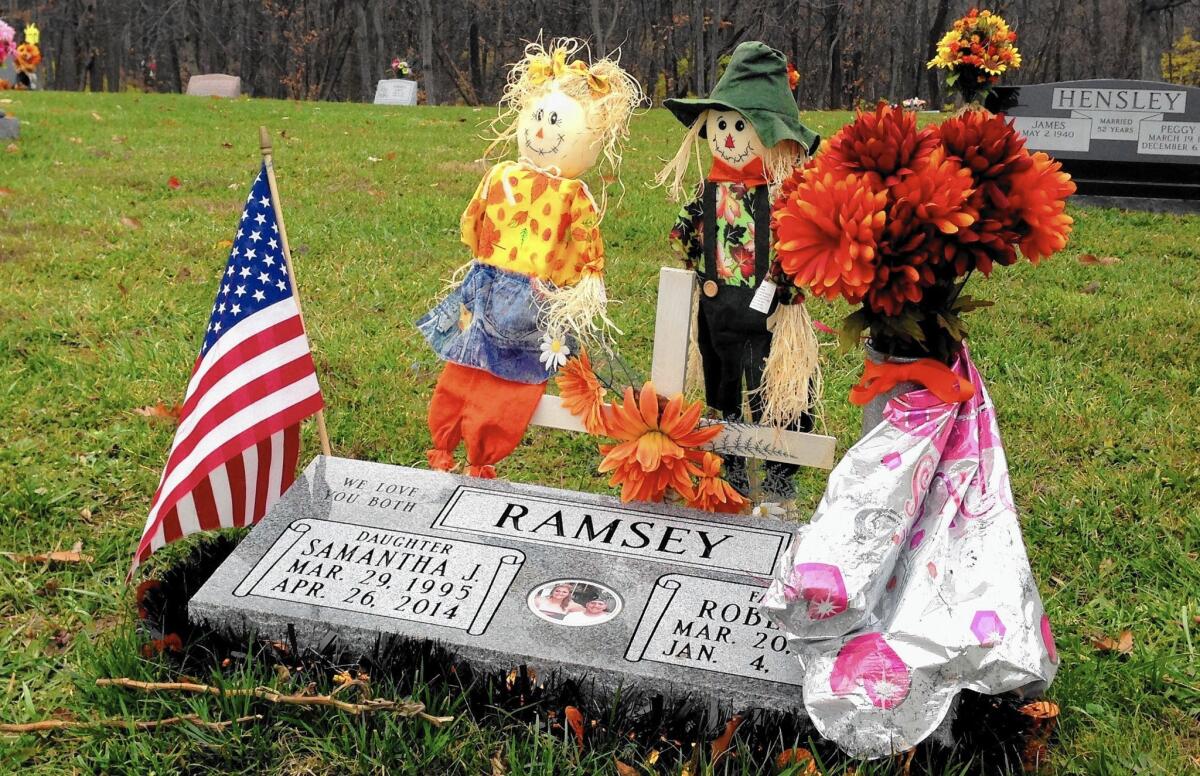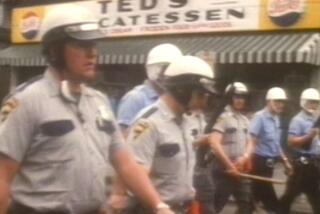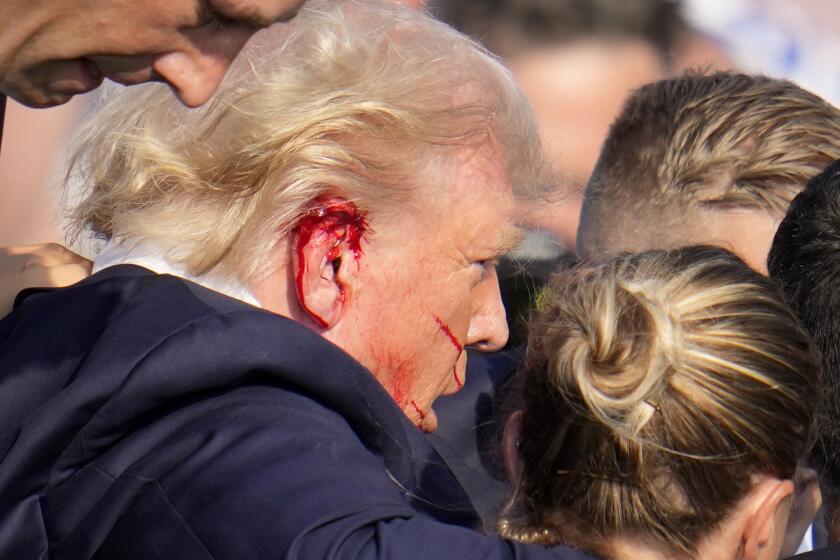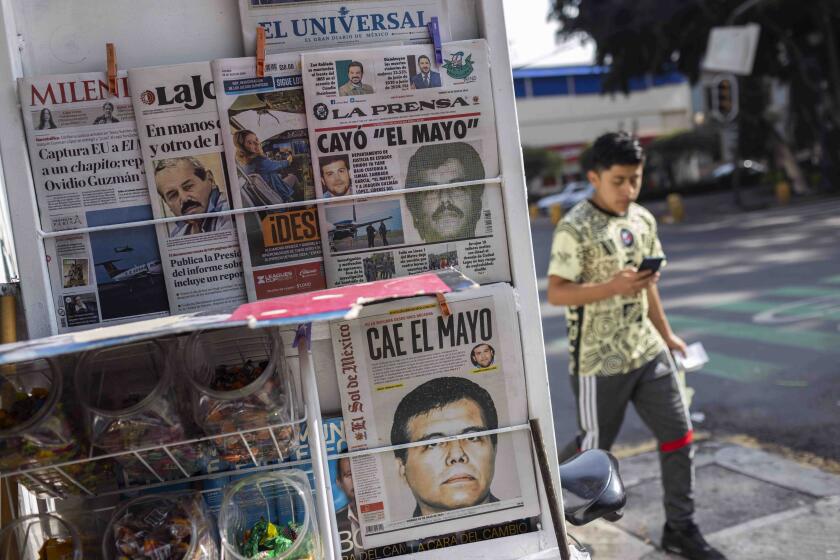Police killing, beating of civilians raise issue of reasonable force

A wooden cross on a narrow, tree-lined road marks the spot where Samantha Ramsey died a violent death.
Passersby might think the marker, etched with the 19-year-old’s name and a yellow smiley face, is a memorial to a car crash victim. They would be wrong.
In April, Ramsey was killed when a sheriff’s deputy fired four bullets through her car windshield as she left a party on the banks of the Ohio River. Ramsey, who did not have a gun, was dead before her mother got to the hospital. A grand jury took one day to review evidence — including the deputy’s testimony that he feared for his life — before declaring the shooting justified.
With that, Ramsey’s relatives joined the ranks of families who demand answers about why lethal force was used, and who decides what is reasonable use of force.
Those questions are in play in Missouri right now, as a grand jury weighs whether to indict police Officer Darren Wilson in the Aug. 9 shooting death of Michael Brown, an unarmed 18-year-old. The incident sparked months of unrest, which is why the city of Ferguson and the surrounding St. Louis area are braced for possible violence whichever way the jury decides.
The hurdles for indicting or convicting a uniformed officer are high, for many reasons.
“There’s a great deal of deserved respect for the difficulties of being a police officer,” said Erwin Chemerinsky, dean of the UC Irvine School of Law. “There’s a desire to give great deference to police officers.”
As with Ferguson, critics sometimes see law enforcement agencies as reluctant to go after their own members. In Brown’s case, the Ferguson Police Department was vilified by protesters after withholding Wilson’s name from the public for a week, giving the officer and his family time to relocate while the case was investigated. Moreover, prosecutors depend on police officers as witnesses, and jurors give officers in peril the benefit of the doubt.
Police use of force is guided by the 4th Amendment, which protects individuals from unreasonable searches and seizures. Another legal standard is that police should use no more force than is reasonably necessary.
The big question is just what is reasonable.
It lies at the heart of Ramsey’s case, Michael Brown’s, and a long list of similar clashes between civilians and police officers that ended with casualties and accusations.
The 1991 beating of Rodney King by Los Angeles police, caught on video, led to charges against four officers. After a jury trial in 1992, all were acquitted, a decision that sparked violent riots across the city and led to Chief Daryl F. Gates resigning and the LAPD reexamining its use of force.
More recently, Kelly Thomas, a homeless man with schizophrenia, was beaten in 2011 by Fullerton police when he wouldn’t follow their commands. Thomas died a few days later. That scene also was captured on video — with Thomas shouting, “Dad, help me!” — and led to charges against three officers. Two were acquitted; prosecutors dropped charges against the third.
“We all look at it from our own perspective,” Chemerinsky said. “Ultimately, either one perceives it as a police officer in a split second using deadly force to protect himself, or a police officer committing murder.”
Law professor Franklin E. Zimring, who directs the criminal justice research program at UC Berkeley’s Earl Warren Legal Institute, said “enormous obstacles” hinder criminal cases involving law enforcement officers.
One impediment is the burden of proof, which requires prosecutors to prove beyond a reasonable doubt that an officer acted improperly. That burden “has special force when you have police officers” on trial, Zimring said.
Another is the question of what police officers feared would have happened had they not acted, he said. And then there is the he-said-she-said nature of most cases, with publicly trusted authorities up against sometimes marginal victims.
“It has to be a really horrendous outlier before you can expect the criminal process to succeed,” Zimring said.
Zimring has analyzed nearly four decades of FBI statistics on police-involved killings — including cases in which officers also were victims.
His research, which has yet to be published, shows an average of 400 civilians, both armed and unarmed, are killed by police in this country each year. It also shows that excessive police violence is usually part of a larger pattern in a law enforcement agency, he said.
Police critics in and around Ferguson argue that their region is evidence of such patterned behavior. Rufus J. Tate Jr., former president of the Mound City Bar Assn., a group of African American lawyers, can tick off a list of Missouri cases involving police charged with serious crimes but cleared of charges.
“A badge is an American halo,” Tate said; it keeps jurors from believing that the men and women assigned to protect them can commit crimes.
In the Ferguson case, Officer Wilson has not spoken publicly about what happened, and no direct video of the shooting has surfaced. According to a preliminary police account, the confrontation began when Wilson spotted Brown and a friend and asked them to get out of the roadway. “The deceased became belligerent,” the report stated.
Wilson opened his door into Brown and the two began to struggle, according to the report. During the confrontation, Wilson’s weapon discharged. Brown then ran, and Wilson pursued him. The report said that Wilson fired several times after Brown turned around and ran toward him. Autopsies indicated Brown was shot at least six times.
The friend who was with Brown, Dorian Johnson, said Wilson at one point grabbed Brown by the neck and said, ‘I’m gonna shoot you.’” As Brown ran away, Wilson shot him in the back, according to Johnson and another witness.
Johnson said Brown then stopped, turned with his hands up, and said, “I don’t have a gun, stop shooting!”
Helmet cameras, dashboard cameras and social media have put a spotlight on cases that might otherwise have gone unnoticed.
The seconds before Samantha Ramsey’s shooting were captured by a video camera on the car of Boone County Sheriff’s Deputy Tyler Brockman, who was responding to another call around 2 a.m. when he came upon a rollicking outdoor party. Brockman told a grand jury he decided to check on drivers leaving the bash because he suspected some were drunk.
Ramsey’s white sedan can be seen attempting to pull onto a dark, two-lane road from a gravel patch. Brockman, who is outside his car, walks toward Ramsey in an attempt to stop her. She keeps moving as the deputy moves alongside her car. Both disappear from view.
The shooting was not caught on video, but the aftermath was.
Smoke billowed from a ditch where Ramsey’s car came to rest. A female passenger staggered into view and dropped to the ground, burying her face in her hands. A young man who was also in the car walked across the road, then fell to his knees, clutched his head in his hands, and rocked back and forth.
A statement released that day by the sheriff’s department said Brockman fired in self-defense after Ramsey accelerated, endangering the deputy.
Some witnesses, including the female passenger, disputed the official account in interviews with local media. They questioned how Brockman, 29, ended up on the car hood and asked why he could not have found a nonlethal way to stop Ramsey.
When the grand jury reviewed the case on Nov. 6, Brockman testified that he had no choice but to jump onto the hood to avoid being run down. In a gripping account, Brockman said he held onto the hood and stared through the windshield at Ramsey. He said he felt cold air on his back as the engine revved.
“And at that point I go, ‘I’m going to die, she is about to kill me, I, I’m going to die,’” Brockman said, according to transcripts released after the grand jury decision. “And, and I went, ‘no, I’m not going to die here, I’m not going to die like this, I’m not going to die on River Road.’
“And I reached down and I grabbed my pistol and I put it up to the window and I fired,” said Brockman, who suffered a broken foot in the melee.
A toxicology report showed Ramsey had marijuana in her system and a blood-alcohol level of 0.120%. In Kentucky, drivers younger than 21 are considered to be under the influence at .02% blood-alcohol level.
Brandi Stewart is convinced her daughter was trying to pull to the side of the road, not to flee or to hit Brockman, and that the deputy overreacted. She said nothing excuses the pumping of four bullets into her daughter at close range.
“She was my only daughter. She was my baby,” said Stewart, who learned of the shooting when the phone rang around 3:30 a.m. on April 26.
The last place she saw her daughter alive was in the small white house they shared in Covington, Ky., a working-class city near downtown Cincinnati. Ramsey was in the bathroom putting on mascara, getting ready to go out for the evening.
Ramsey, a cheerleader in high school, was known for her habit of bringing home strays — both pets and people, her mother said. “I raised more friends of hers than I care to count,” said Stewart, a nurse who raised Ramsey and her two older brothers in Covington.
In an interview Thursday, one week after the grand jury decided not to indict Brockman, Stewart showed little sign of anger at the deputy. In fact, Stewart said she was praying for Brockman and his family.
Her anger is reserved for a system that allows law enforcement agencies to investigate their own, she said.
“Do I think there’s a good ol’ boys club? Yes, I do,” she said. “Do I think they cover up for their own? Yes, I do.”
Five days after Ramsey died, Boone County Sheriff Michael Helmig asked Kentucky State Police to investigate the shooting amid allegations it should be reviewed by an outside party. The state police refused in part because too much time had passed since the incident, the Cincinnati Enquirer reported, quoting department spokesman Sgt. Michael Webb.
“When there’s a few days of time that has elapsed, where the scene has been cleaned up, it’s been compromised, and witnesses aren’t around ... it would make it basically impossible for us to investigate thoroughly and effectively,” Webb told the newspaper.
Ramsey was buried May 2 beside her father, Robert Ramsey, who died of a heart attack last year. On a recent afternoon, the hilltop grave was decorated with an American flag and cheery signs of autumn: a bunch of orange flowers and two smiling scarecrows.
Brockman returned to work Nov. 10.
Susman reported from Kentucky and La Ganga from Seattle. Times staff writer Matt Pearce contributed to this report.
More to Read
Sign up for Essential California
The most important California stories and recommendations in your inbox every morning.
You may occasionally receive promotional content from the Los Angeles Times.







